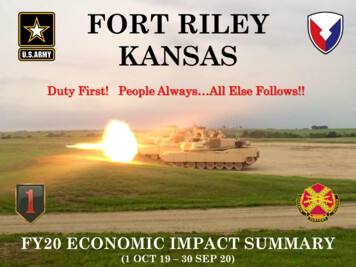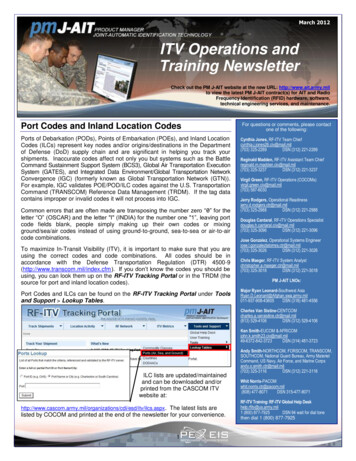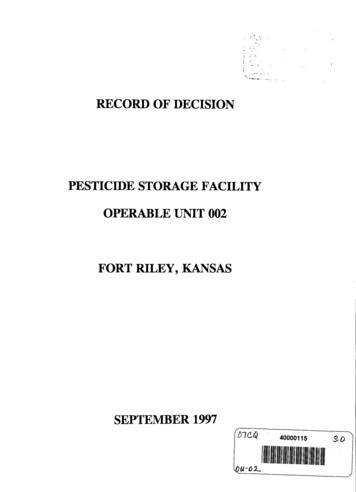
Transcription
FORT RILEYKANSASDuty First! People Always All Else Follows!!FY20 ECONOMIC IMPACT SUMMARY(1 OCT 19 – 30 SEP 20)
Table Of ContentsOverview – Who We Are .Command Group . . Unit Information . . . .Economic Impact . . .Payroll . .Service and Supply . .Construction . .Education . . .Veteran Expenditures . .Health Care . . .Population . Infrastructure . . .Deployment . . .Training . . . . .Safety . . . .Environment . . .Housing . . .Continuous Process Improvement . On & Off Post Partner Organizations . .COVID-19 . . Soldier Transition .Quality of Life . Contributors . . .12346891011121314181921252627313233343641
Overview – Who We AreDepartment of the ArmyThe U.S. Army’s mission is to fight and win our nation’s wars by providingprompt, sustained land dominance across the full range of militaryoperations and spectrum of conflict in support of combatant commanders.1st Infantry Division and Fort RileyThe 1st Infantry Division and Fort Riley build and maintain combat readyforces; on order deploys these forces to conduct Decisive Action to fightand win in complex environments as members of a Joint, Interorganizational, and Multinational (JIM) team.Army Materiel CommandThe U.S. Army Materiel Command leads and directs logistics andsustainment efforts at the strategic, operational and tactical levels to bestmeet Army readiness requirements.Installation Management Command / GarrisonIMCOM delivers quality base support from the Strategic Support Area,enabling readiness for a globally responsive Army.USAG consists of the HQ and HQ Company; Emergency Services;Family, Morale, Welfare and Recreation; Human Resources; Plans,Training, Mobilization and Security; Public Works; Equal EmploymentOpportunity; Garrison Safety; Plans, Analysis and Integration; PublicAffairs; Resource Management; and Staff Judge Advocate.“Fort Riley - A Great Place to Live, Train, Deploy From, Come Home to and Retire”2
Command Group1st Infantry Division Command GroupCommanding GeneralCommand Sergeant MajorDeputy Commanding Officer - (Support)Deputy Commanding Officer - (Maneuver)Chief of StaffMajor General D. A. Sims IICommand Sergeant Major Raymond S. HarrisBrigadier General Thomas O’ConnorColonel Andrew C. GaineyColonel Kevin LambertGarrison Command GroupGarrison CommanderGarrison Command Sergeant MajorDeputy Garrison CommanderColonel William B. McKannayCommand Sergeant Major Timothy V. SpeichertMr. David FullmerMajor Subordinate and Tenant Commanders1st Armored Brigade Combat Team (ABCT)2nd Armored Brigade Combat Team (ABCT)1st Infantry Division Sustainment Brigade1st Infantry Division Artillery (DIVARTY)1st Combat Aviation Brigade (CAB)Medical Department Activity (MEDDAC)Dental Activity (DENTAC)Army Field Support Battalion - Riley, 407th (AFSB)Division HQ and HQ Battalion10th Air Support Operations Squadron (ASOS)97th Military Police BattalionColonel Paul KrattigerColonel Thomas B. SmithColonel Brian S. OlsonColonel Timothy R. MungieColonel Bryan J. ChiversColonel Edgar G. ArroyoColonel Susan M. CebulaLieutenant Colonel Paul LicataLieutenant Colonel John BrockLieutenant Colonel John SiepsLieutenant Colonel Michael A. Thurman3
Unit Information - 1st Infantry DivisionDivision Headquarters and Headquarters Battalion, 1st Infantry DivisionThe Division Headquarters and Headquarters Battalion (DHHB) consists of four Companies whose missionis to support the 1st Infantry Division.1st Armored Brigade Combat Team, 1st Infantry DivisionThe 1st Armored Brigade Combat Team (ABCT) consists of: 1st Battalion, 16th Infantry Regiment; 2ndBattalion, 34th Armor Regiment; 3rd Battalion, 66th Armor Regiment; 1st Squadron, 4th CavalryRegiment; 1st Battalion, 5th Field Artillery; 1st Brigade Engineer Battalion; and 101st Brigade SupportBattalion.2nd Armored Brigade Combat Team, 1st Infantry DivisionThe 2nd Armored Brigade Combat Team (ABCT) consists of: 1st Battalion, 18th Infantry Regiment; 1stBattalion, 63rd Armor Regiment; 2nd Battalion, 70th Armor Regiment; 5th Squadron, 4th CavalryRegiment; 1st Battalion, 7th Field Artillery Regiment; 82nd Brigade Engineer Battalion; and 299th BrigadeSupport Battalion.Division Artillery, 1st Infantry DivisionDivision Artillery (DIVARTY) provides a single proponent within 1st Inf. Div. for standardized firescertification and leader development while exemplifying effective Mission Command (Art 5.0); andsupporting the seamless cross-attachment of units with common procedures and a shared understandingof the Fires warfighting capabilities.1st Sustainment Brigade, 1st Infantry DivisionThe 1st Sustainment Brigade consists of: HHC, 1st Sustainment Brigade; Special Troops Battalion, 1stSustainment Brigade; 541st Combat Sustainment Support Battalion.Combat Aviation Brigade, 1st Infantry DivisionThe Combat Aviation Brigade (CAB) consists of HHC, CAB; 1st Attack Reconnaissance Battalion, 1stAviation Regiment; 2nd General Support Aviation Battalion, 1st Aviation Regiment; 3rd Assault HelicopterBattalion, 1st Aviation Regiment; 601st Aviation Support Battalion;1st Squadron, 6th Cavalry Regiment.4
Unit InformationU.S. Army Medical Department Activity (MEDDAC)Irwin Army Community Hospital (IACH) provides quality healthcare to the Soldiers, families, and retirees ofthe Central Flint Hills Region. The hospital operates Farrelly, Custer Hill and Aviation Health Clinics onFort Riley, and the Flint Hills Medical Home in Junction City.Midwest Region Network Enterprise Center (RNEC)The RNEC mission is to build, and sustain, a community of Command, Control, Communications,Computers, and Information Management (C4IM) service providers in the Midwest Region who arededicated, innovative and adaptive, with positive customer relationships.10th Air Support Operations Squadron (10 ASOS)Provides combat-ready Tactical Air Control Party assets for combat maneuver units of the 1st InfantryDivision. Advises the Army on U.S./Allied air capabilities. Coordinates attack/reconnaissance air assets insupport of the joint battle plan.Army Field Support Battalion - Riley (AFSBn-Riley), 407th AFSBThe AFSBn-Riley exercises authority over and develops plans and policies for all installation logisticsactivities, supply, services, installation logistics automated systems, maintenance and transportation.Civilian Human Resources Agency (CHRA) Southwest RegionThe CHRA SW Region provides regional oversight and support to 18 Civilian Personnel AdvisoryCenters with a presence in 16 states. Home to the Army Benefits Center-Civilian providing world-widebenefits services and centralized workers compensation and unemployment compensation benefits toover 300,000 DA civilians, DECA, DoDEA, DHA and the Army and Air National Guard. Also home tothe Civilian Personnel Records Center-KS (CIVPRC-KS), one of two in the Army, providing processingsupport to the CHRA SW Region, West, Europe, and Far East Regions.Mission Installation Contracting Command (MICC)The 923d Contracting Battalion/Mission and Installation Contracting Command-Fort Riley providescontracting support to the warfighter, 1st Infantry Division and Fort Riley to enable global readinessthrough tailored and innovative business advice solutions.Defense Military Pay Office (DFAS)DMPO delivers and administers superior financial services in an efficient, effective and timely manner forFort Riley Soldiers and their families while setting the standards in customer service as leadersthroughout all of the Defense Finance Accounting System.5
Fort Riley Economic ImpactFort Riley’s direct* fiscalyear (FY) 2020 economicimpact was 1.8B.PayrollFY 16Contracts: Supply and Service 160,606,228Construction 64,612,049VA Expenditures 183,682,000Education 26,713,288Health Care 80,434,650 1,728,126,450TOTAL ECONOMIC IMPACTPayrollFY 17Contracts: Supply and Service 71,619,284VA Expenditures 201,332,000Education 31,110,574Health Care 76,364,957 1,759,265,423TOTAL ECONOMIC IMPACTPayrollFY 18Contracts: Supply and Service 40,951,262VA Expenditures 205,929,000Education 17,900,223Health Care 81,940,969 1,732,865,360TOTAL ECONOMIC IMPACTFY 19Contracts: Supply and Service 71,975,453VA Expenditures 208,217,000Education 53,212,228Health Care 86,316,820 1,751,848,044TOTAL ECONOMIC IMPACTContracts: Supply and ServiceConstructionChanges and increases in economic impact totals from previousFort Riley economic reports are a result of modifications andimprovements in data collection sources.6VA ExpendituresEducationHealth CareTOTAL ECONOMIC IMPACT 1,177,539,103 154,587,440ConstructionPayroll 1,201,322,158 184,821,748ConstructionPayroll 1,239,869,467 138,969,141Construction* Direct No economic multipliers applied. 1,212,078,235FY 20 1,213,173,027 193,725,857 69,149,755 233,107,000 18,252,984 87,485,500 1,814,894,123
Economic ImpactIn FY20, Fort Riley utilized innovative solutions and creative best practices to(20%)mitigate the current COVID-19 environment and funding/manning shortfalls.Fort Riley continues to pursue additional mutually beneficial communitypartnerships that will enhance mission readiness and improve cost efficiencies.PayrollContracts - Service and SupplyConstructionVeteran ExpendituresEducation: Federal Impact AidHealth Care 1,213,173,027 193,725,857 69,149,755 233,107,000 18,252,984 87,485,500Total Direct Economic ImpactWith a generally accepted Congressional Budget Office(CBO) economic multiplier of 2.2 per 1 of directexpenditures, Fort Riley's full economic impact would bemore than:7 1,814,894,123 3,992,767,070
Economic Impact – PayrollFort Riley is the largest employer in the Central Flint Hills Region. Additional governmentagencies and Kansas State University are also primary employers in the region. 849,916,972 213,054,715Military Base Pay*Federal Civil Service Civilian PayNon-Appropriated Fund Civilian Pay** 12,042,707Non-Federal Civilian Pay 22,474,717Retiree Annuities (DOD Office of the Actuary) 1,213,173,027Total Payroll* Military payroll provided by Defense Military Pay Office; Federalcivil service civilian pay information provided by RMO and G8. 115,683,9168** Non-appropriated fund civilian pay provided by DFMWR; Non-federal civilian payinformation compiled by PAIO.
Economic Impact - Service and SuppliesContracts: Service and SupplyMission & Installation Contracting Command (MICC) 25,714,964Energy Savings Performance Contract (ESPC) 6,571,433Non-MICC Appropriated Funds (APF) 50,035,338- Supplies 110,426,387- Services 160,461,724Total Appropriated FundsNon-MICC Non-Appropriated Funds (NAF) 623,989- Supplies 353,747- Services 977,736Total Non-Appropriated FundsTotal Contracts/Supplies/ServicesDPW receives the SECARMY’s Energy and Water Management Award9 193,725,857
Economic Impact – ConstructionAppropriated Funds (AF):Army Corps of Engineers Military Construction, payments made- Army Corps of Engineers contracts awarded- Army Corps of Engineers contracts completed 54,945,000 206,996,461 13,737,463 8,082,478Non-Army Corps of Engineers contractsNon-Appropriated Funds (NAF): 237,077NAF capital purchase & minor constructionOther Construction:Corvias (Private Housing Partner) construction and propertymaintenanceTotal Current Year Payments 5,885,200 69,149,755AF contract data provided by the U.S. Army Corps of Engineers; NAF contract data provided by DFMWR; Non-Army COE contract data provided by MICC.10
Economic Impact - Veteran Expenditures*Compensation and pension expenditures include dollars forthe following programs: veterans' compensation for serviceconnected disabilities; dependency and indemnitycompensation for service-connected deaths; veterans' pensionfor nonservice-connected disabilities; and burial and otherbenefits to veterans and their survivors.Medical Care expenditures include dollars for medicalservices, medical administration, facility maintenance,educational support, research support, and other overheaditems. Medical care expenditures do not include dollars forconstruction or other non-medical support.Compensation& PensionClay CountyDickinson CountyGeary CountyMorris CountyPottawatomie CountyRiley CountySaline CountyWabaunsee CountyTotalEducation & VocationalInsurance &Rehabilitation/IndemnitiesEmploymentMedical CareTotalExpenditures 9,492,000 23,432,000 83,633,000 5,612,000 14,551,000 60,940,000 30,481,000 4,966,000 6,189,000 13,817,000 51,699,000 3,018,000 7,598,000 35,211,000 13,611,000 2,926,000 575,000 1,675,000 11,008,000 261,000 907,000 11,736,000 2,200,000 179,000 79,000 36,000 247,000 48,000 65,000 368,000 300,000 9,000 2,649,000 7,904,000 20,679,000 2,285,000 5,981,000 13,625,000 14,370,000 1,852,000 134,069,000 28,541,000 1,152,000 69,345,000Regional Veteran population and expenditure data providedby the Department of Veterans Affairs. 233,107,000* Figures are as of 30SEP2019. FY20 data will be available in Aug 2021.11
Economic Impact – EducationDependents of Soldiers andfederal employees account for6,423 students or 21% of the totalstudent population in the CentralFlint Hills Region.Payments from Federal Impact AidUSD 475 (Geary County)4,627 Students 17,825,307USD 383 (Manhattan-Ogden)989 Students 114,568Other Districts807 Students 313,109Total Payments from Federal Impact AidFederal impact aid data provided by DFMWR CYS School Liaison Officer.12 18,252,984
Economic Impact – Health CareIrwin Army Community Hospital (IACH) is a 47-bedhospital designed with the latest medical engineeringtechnology to deliver the best care to our Big RedOne Soldiers and mission partners, their families andour retirees.IACH serves over 43,710 beneficiaries every year. Ona typical day, it sees 1,400 clinical patients, 64 ERvisits, 1,429 prescriptions, runs 1,178 laboratoryprocedures, 169 vaccinations, performs 7 surgicalcases, and delivers 2 babies.Outsourced (off-post) Patient CareNumber of PatientsAmount PaidTotal outpatient care42,457 48,568,287Total inpatient care1,242 12,995,71343,699 61,564,000Total outsourced patient careHealth CareHospital expenses (minus construction, payroll, contracts) 25,921,500Outsourced patient care (see above) 61,564,000Total health care expensesHealth care data provided by MEDDAC, RM Division and includesFlint Hills Medical Home and Dental Activities. 87,485,50013
PopulationPopulation data reflects the surrounding Flint Hills Region including Clay County, DickinsonCounty, Geary County, Morris County, Pottawatomie County, Riley County, Saline County andWabaunsee County.Military* (Army)Officers14,9981,537Warrant OfficersEnlisted43913,022Military (Air Force)130Family Members15,703On Post8,477Off Post7,226Veterans**26,533Retirees4,810Civilian EmployeesTotal Population* Military population data provided by G-1 Strength Management;family member population data provided by MEDDAC – DEERS.(including Contractors)5,48867,662** Veteran/retiree data provided by the Department of Veterans Affairs;civilian employee population data provided by CPAC and PAIO.14
Population - Civilian WorkforceDepartment of the Army Appropriated Fund EmployeesOther Federal Employees2,460390Non-Appropriated Fund EmployeesOther Civilian Employees (including Contractors)*4352,203Total Civilian Employees5,488* Other Civilian Employee Breakdown (including Contractors)10th ASOS, USAF10 DFMWRArmy & Air Force Exchange Service (AAFES)270 Division G2AAFES Concessionaires57 Division G4Advanced Turbine Engine Army Maintenance70 DPW – Energy & Conservation BranchArmed Forces Bank, N.A7 DPW - Environmental DivisionArmy Field Support Brigade (AFSBn)279 DPTMS, Various Training SitesAviation Field Maintenance Activities24 Equipment Concentration Site #33Azura Credit Union2 EnvisionCamp Funston KSARNG9 InterContinental Hotel Groups (IHG)Commissary (DeCA)27 MEDDAC/DENTACCorvias188 United Services Organization (USO)DHR - Education Services11 USD 475 On-Post PersonnelDHR - SRP/SFL-TAP14 Vyve BroadbandTotal Other Civilian Employees* Contractor numbers do not include many service contractors whowork less than full time or whose physical office location is other thanFort Riley, such as landscaping, maintenance, custodial, etc.151072827231514525113854872,203
Population – Military RetireesMilitary retirement population numbers include members of theArmy, Navy, Marine Corps, Air Force and Coast Guard.Expenditures include non-disability retired pay, disability retiredpay, retired pay for reserve service, survivor annuity programsand special compensation programs for certain disabledretirees.PopulationExpendituresClay CountyDickinson CountyGeary CountyMorris CountyPottawatomie CountyRiley CountySaline CountyWabaunsee County2365111,861912431,39837793 5,484,445 11,471,141 41,432,754 2,001,870 6,177,349 38,967,752 8,164,502 1,984,103Total4,810 115,683,916Regional retiree population data provided by DOD Office of the Actuary16
Population - Veterans *Population data includes non-retired veterans registered withand eligible for benefits from the Department of VeteransAffairs.VA expenditures include compensation and pension; educationand vocational rehabilitation and employment; insurance andindemnities; and medical expenditures.PopulationExpenditures982 9,492,000Dickinson County2,078 23,433,000Geary County8,492 83,632,000Morris County592 5,612,000Pottawatomie County1,805 14,552,000Riley County8,213 60,940,000Saline County3,786 30,481,000585 4,966,00026,533 233,108,000Clay CountyWabaunsee CountyTotal Figures above are as of 30SEP2019.FY20 data will be available in Aug 2021.Regional veteran population and expenditure data provided by theDepartment of Veterans Affairs.17* See page 13 for additional Veteran Expenditure Data.
InfrastructureFort Riley has access to 34,000 additional training acres (prairie land) at the Great Plains Joint TrainingCenter in Salina, Kansas, 60 miles away. This area is the largest inert bombing range east of theRockies and provides exceptional joint training opportunities for heavy forces’ collective, distributed,Joint (10th Air Support Operations Squadron - JTACS/FOs and Joint Fires), Inter-organizational, andMultinational (JIM) training in coordination with our Kansas National Guard partners.Acreage% Total AcreageTraining Area69,42276%Impact Area13,39015%Maneuver Lane (Fixed Gunnery Ranges)6,3657%Major Water Bodies (Floating Bridge Site)2620%2,1852%91,624100%Military RangesTotal Acreage for TrainingTotal Installation Acreage 101,732.91Buildings excluding Housing- Number of Buildings- Historical Buildings:- Square Footage w/o housing86215612,258,200Transportation Network (Miles)- Paved (Cantonment Area)- Unpaved/Dirt (Training Area)- Tank Trails- Range Roads- Railroad Tracks15518016914816Total Miles66818Infrastructure information provided by DPW and DPTMS.
Deployment – Rail YardWhen driving past the rail tracks in Camp Funston, it’s not uncommon to see a red locomotive pullingcars along the tracks for several hours a day and multiple weeks at a time. Army Field SupportBattalion (AFSBn) railhead staff operate as a two-man team to ensure the equipment brigades use andneed is available to make it safely to their training installation or port destination for eachdeployment.Fort Riley can deploy Soldiers and equipmentof a brigade-sized element in 96 hours with anestimated throughput of 400 rail cars a day.- 14 loading spurs, 6 double wide end loading ramps, 2 single wide loading ramps and 3 sideloading ramps- Light banks: 12 stadium lights in main rail yard (1 ea. Northside, 1 ea. Southside yard and 5 eachEastside, and 5 ea. Westside yard) 3 stadium lights in east rail (1 ea. Eastside, 1 ea. Southside, and 1 ea. on the Westside) 21 half high lights in east rail (5 ea. of Eastside, 5 ea. in the center, 10 ea. on Westside)These four spurs have the lights that illuminate at car deck height to assist tie down ofvehicles after dark 10 stadium lights along the Southside of the interchange yard.-Reinforced docks with shock absorbers – three concrete docks for loading equipment that willbe shipped by truck, two on Custer Hill and one at Camp Funston, and three portable docksfor loading equipment that will be shipped by truck at Camp Funston-Movement Control Center and Control Tower-3 engines to move train to loading facilities-Weighing facilities-Side Rail holds 455 ea. 89’ carsDeployment capability data provided by Army Field Support Battalion-Riley, 407th AFSB.19
Deployment – AirfieldsFort Riley's robust deployment capability issupported by 3 local airfields available forsimultaneous use.Manhattan Regional Airport features a 460,000 sq. ft. ArmyDeployment Ramp which allows Fort Riley to use the facility as aRapid Deployment Facility for a Quick Reaction Force (QRF)mission in support of Homeland Defense. The apron area has beendesigned to allow two C-17 aircraft to park simultaneously.- Primary commercial service airport – more than 10,000enplanements per year- Two runways – 7,000 feet long and 5,000 feet longSalina Regional Airport serves as a forward operating location formilitary aviation units deploying to Saline County and the GreatPlains Joint Training Center operated by the Kansas National Guard.- Primary runway is 12,300 feet long- Crosswind runway is 6,500 feet long- 2.7 million sq. ft. of ramp space- Excess of 10,000 sq. ft. of hangar space- Primary runway, taxiway and aircraft parking apron can support allUSAF transport aircraft in the AMC fleetTopeka Regional Airport (Forbes Field) has two runways andmore than 2 million square feet of apron space available for transientmilitary, general aviation and commercial aircraft.- Primary runway is in excess of 12,800 feet long- Crosswind runway is 7,000 feet long20
TrainingFort Riley completed Aerial Weapons Scoring System (AWSS) Fielding. Upgrade provides DMPRCwith DAGIR like embedded Aviation Scoring capability for both Attack Aviation and Door Gunnery.AWSS engagement data feeds directly into Digital Range Training System (DRTS) providingintegrated AAR data to existing range data improving overall combat aviation readiness.Tracked Vehicles:Tanks174Total Army Training PartnersBradleys2771-113 IN (IA ARNG)KSU ROTCOther3891-161 FA Bn (KS ARNG)1-133 IN (IA ARNG)Wheeled Vehicles:3,841Aircraft:Rotary Wing113Unmanned Aerial Systems38- Ravens20- Shadow12- Gray Eagle2-130 FA Bn (KS ARNG)1-113 CAV (IA ARNG)891 EN Bn (KS ARNG)1-168 IN (IA ARNG)45 IBCT (OK ARNG)1-134 CAV (NE ARNG)5th EN (AD FLWMO)1-635 AR (KS ARNG)(Reflagged from the2-137 IN Bn)Training data provided by DPTMS and 1ID G4.21
Training - Regional and JointFort Riley is the only FORSCOM installation in the Midwest with complete, modern, state-of-the-art,full-spectrum training capability (live maneuver area, virtual, constructive, gaming in IntegratedTraining Environment) to support “Total Army,” Joint, Inter-organizational, and Multinational (JIM)training for the Midwest, our state, regional and local partners.Fort Riley Annual Off-Post Training Throughput*FY20 – Reduced throughput due to COVID-19 travel restrictions and mitigation concerns.Fort Riley completes site improvement to Williams Drain(Training Area 64) providing FRKS a secondary, 200 meterlong, Floating Bridge Site, validating FRKS ability to supportfuture MRBC stationing actions and conduct FBSoperations for 1ID Organic or Total Army Partner Units atmultiple locations.*Training data provided by DPTMS.Fort Riley creates a dedicated EIB/EFMB/ESB sitevalidating FRKS ability to conduct EIB/EFMB/ESBoperations at a dedicated location, codifying FRKS as aprimer training installation and increasing the MissionReadiness of 1ID and Total Army Partner Units.22
Training - Regional and Joint**FY20 –Training reduced due to COVID-19 travel restrictions and mitigation concerns.Note: Does not include Active Component Brigade Combat Teamsstationed on Fort RileyThe Camp Funston Reserve Component TrainingComplex consists of:-4 billets with a total bed space of 1,3441 assembly/feeding area that seats 164Battalion administration areas2 motor pools6 relocatable arms roomsTraining data provided by DPTMS.23
Training - RangesRange 1Range 1A, Range 3ARange 2Range 3Range 4Range 5Range 6Range 7Range 7ARanges 8,15,17,19,27 &51Range 9Range 10Range 16Gunnery SouthRange 25Range 29Range 34Range 52QTR MPMGSACRange 54Douthit Complex DMPRC & DMPTRDouthit Complex-ZeroShoothouse 1Shoothouse 5Range 53Training Area 16MRF/Qualification/Night/Field FireZero RangeCombat Pistol Qual RangeMRF/Qualification/Night/Field FireGrenadier Gunnery, 12-lane zero range &privately owned weapons/6 lane; M203qual/2 lane team maneuverUrban Assault CourseZero Range, Sniper Range, Reflex FireMultipurpose Machinegun/Zero RangeFamiliarization RangeIED LaneTLC-1 & TLC-2MFP-4, MFP-6MFP-12, MFP-14HSTL/JIEDDOTeam Live-Fire CourseMortar Firing PointMortar Firing PointCombat TrailEmergency Ordnance Disposal (EOD) Enemy Equip TrainingOP-B, OP-C, OP-D, OP-EUC-0, UC-1, UC-2, UC-3UC-4, UC-5, UC-6Afghan VillageObservation Point for Mortar or Artillery FireUrban Cluster/Combat in the CityUrban Cluster/Combat in the CityUrban Cluster-Largest Wall TownInactiveObstacle CourseIndividual Phy. Fitness Confidence BuilderMachine Gun qual/fam/zero/SRTISBC Infantry Squad Battle CourseEmergency Ordnance Disposal TrainingScout Recce/MK 19/SniperHand Grenade Qualification and Live-FireMK 19 Live-Fire//AT-4/M320/203Skeet/Trap for DFMWRDemolitions & Breach TrainerQualification Training - Machine GunSquad Assault CourseLive-Fire VillageDigital, Multi-purpose Range Complex/Stationary Gunnery/Aerial GunneryZero ComplexLive-Fire ShoothouseLive-Fire Shoothouse/ Zero RangeIPBC Infantry Squad/Platoon Battle courseBDE Staging AreaRappel TowerFLRCCACTFOffense/Defense BuildingMock AirfieldMHSCKDRQTR MRFQTR SniperFLSQTR CPQCRappel TowerField Leaders Reaction CourseCombined Arms Collective Training FacilityOffense/Defense BuildingMock AirfieldMortar Hip Shoot CourseKnown Distance RangeQualification Training - Modified Record FireQualification Training - Range SniperField Landing StripQualification Training - Combat PistolHERC NAV DZDrop ZoneTimber Creek DZTrench ComplexMine AreaFBSRange 7 UCDrop ZoneTA-16 Trench TrainingTA-16 Mine Warfare TrainingFloating Bridge SiteCALFEX Assault Village
Safety - Federal EmployeeCompensation Act (FECA)Through the efforts of the Soldiers, Department of the Army civilians and other Fort Riley communitymembers, USAG Fort Riley reduced the total number of accidents during FY20.MEDICAL COSTCOMPENSATION COSTTOTAL2016 32,195.77 82,966.30 115,162.072017 43,756.69 78,016.38 121,773.072018 50,733.00 153,337.06 204,070.062019 45,675.72 136,698.18 182,373.902020 47,582.08 133,318.79 180,900.87Cost-Conscious, Safe and Efficient Installation- FECA cost is a significant data point for being selected for safetyachievements- Achieved 10 of 12 Safety Goals for FY20- Reduced total Class C and Class D accidents by 17% from ourfive year average- Reduced days away by 295 from our five year averageFECA data provided by the Garrison Safety Office.25* Data for 2020 reflects IMCOM at Fort Riley only
EnvironmentHay and Crop Lease PartnershipAgricultural use of Fort Riley’s training landsoccurs when and where it is compatible with themilitary mission. Currently, the DPWFY16Environmental Division manages 1,600 acres ofFY17grain-producing firebreaks and 38,000 acresleased for cool- and warm-season hay production.-Maintains open space for military trainingReduces potential for wildfiresSuppresses woody plant encroachmentReduces expense for grounds managementSupports regional demand for livestock feedFinancialBenefit 300,000Net Increasein RevenueGeneration 120,000Total NetFinancialBenefit 420,000 325,000 120,000 445,000FY18 325,000 120,000 445,000FY19 350,000 120,000 470,000FY20 350,000 120,000 470,000Total 1,650,000 600,000 2,250,000Joint Land Use Study (JLUS)A JLUS is a collaborative study conducted by city and countyofficials, local residents, key stakeholders and the militaryinstallation to identify compatible land uses and growthmanagement guidelines near the installation. The processencourages them to act as a team to prevent or limit anyencroachment issues caused by future mission expansion orlocal growth. The study is funded primarily through the DODOffice of Economic Adjustment (OEA) but is created by thecommunity and for the community. JLUS report completed inAugust 2017 with ongoing implementation of recommendationsfor the JLUS report.Environmental data provided by DPW.26
Housing - On-Post ResidentialFort Riley housing is owned by Corvias, an Army partner and private company, who manages it in conjunctionwith the Fort Riley Garrison Housing Management office. Fort Riley leaders and Corvias share the same goal:providing safe, quality family housing and timely maintenance for our Soldiers and families.CorviasFamily Quarters- Officer- EnlistedTotal Square Footage3,8274383,3896,560,069Community Centers5Neighborhood Pools4Housing data provided by DPW and Corvias.27
BasicAllowanceAllowance for(BAH)BasicforHousingHousing(BAH)The Basic Allowance for Housing (BAH) is a U.S.-based allowance prescribed by geographic dutylocation, pay grade, and dependency status. It provides uniformed service members (SM) equitablehousing compensation based on housing costs in local civilian housing markets within the UnitedStates when government quarters are not provided.Fort Riley’s BAH rate is the among lowest among Division-level installations, making itcost effective and fiscally beneficial to the DOD and Army.Military ServiceGradeBAH Paid to SM’sCollecting BAH w/Dependents(non-barracks SM)E1-
** Non-appropriated fund civilian pay provided by DFMWR; Non-federal civilian pay information compiled by PAIO. Fort Riley is the largest employer in the Central Flint Hills Region. Additional government agencies and Kansas State University are also primary employers in the region. Military Base Pay* 849,916,972










